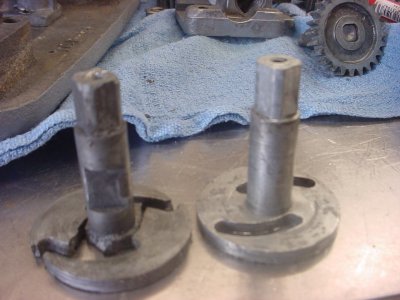-
Welcome back Guest! Did you know you can mentor other members here at H-M? If not, please check out our Relaunch of Hobby Machinist Mentoring Program!
You are using an out of date browser. It may not display this or other websites correctly.
You should upgrade or use an alternative browser.
You should upgrade or use an alternative browser.
Scroll and guide busted; need confirmation on part numbers
- Thread starter ARC-170
- Start date
- Joined
- Dec 25, 2011
- Messages
- 10,552
There is probably someone around who made special tools for slotted nuts. But I never found them. I make tools for removing and installing that kind of nut out of cheap deep pattern 12-point sockets of the appropriate diameter, and once made, hang onto them.
I never heard of a tapered gib. The cross slide looks like the early one that had two captive bolts. But the compound swivel doesn't. The compound slide on the right looks like the standard 10# one.
The late 12" (both Atlas and Craftsman) did use the 10D-38 Scroll. And has a lever retained by an oval head (rack and panel) screw.
I never heard of a tapered gib. The cross slide looks like the early one that had two captive bolts. But the compound swivel doesn't. The compound slide on the right looks like the standard 10# one.
The late 12" (both Atlas and Craftsman) did use the 10D-38 Scroll. And has a lever retained by an oval head (rack and panel) screw.
- Joined
- Oct 17, 2018
- Messages
- 966
- Joined
- Oct 17, 2018
- Messages
- 966
The only difference that I see is tha the old one has a flat machined on the side. What is that for?
That is the only difference, you are correct. The flat allows the #L6-265 plunger to move in and out when the #10-29 lever is used to rotate the scroll. It's like a cam. I think it prevents using the cross-feed and main feed from being engaged at the same time.
- Joined
- Dec 25, 2011
- Messages
- 10,552
Ah! OK. The scroll that you had was modified for use only in a Sears early 12" machine. For some reason, Sears insisted on having the mechanical interlock that prevented the operator from engaging both drives at the same time. None of the Atlas machines had this feature, which I consider to be unnecessary. And it was not on the late 1/2" bed 12" machines made 1957 - 1981. Neither were the other oddities. The machined flat was dropped after 1957. And the replacement scrolls became the same for 10" and 12" machines.
I wouldn't say that it is worth disassembling the apron to remove them but you could have simply omitted the interlock parts (Plunger, Spring and Spacer) and used the scroll as received. Sorry that I didn't think of that.
I wouldn't say that it is worth disassembling the apron to remove them but you could have simply omitted the interlock parts (Plunger, Spring and Spacer) and used the scroll as received. Sorry that I didn't think of that.
- Joined
- Oct 17, 2018
- Messages
- 966
Ah! OK. The scroll that you had was modified for use only in a Sears early 12" machine. For some reason, Sears insisted on having the mechanical interlock that prevented the operator from engaging both drives at the same time. None of the Atlas machines had this feature, which I consider to be unnecessary. And it was not on the late 1/2" bed 12" machines made 1957 - 1981. Neither were the other oddities. The machined flat was dropped after 1957. And the replacement scrolls became the same for 10" and 12" machines.
I wouldn't say that it is worth disassembling the apron to remove them but you could have simply omitted the interlock parts (Plunger, Spring and Spacer) and used the scroll as received. Sorry that I didn't think of that.
But that explains the difference between L6-38 and 10D-38. Which part number did you ask for?
I just followed the exploded parts diagram when I was reassembling the machine. That's an interesting bit of history, though. Based on the bearing dates, this lathe was made around Nov of 1950. Had I known, I would have just omitted the plunger, etc.. Not a big deal, though.
I was looking for an L6-38, since that's what's in the parts diagram. But, these both had the same part number (10D-38) molded into them.
- Joined
- Dec 25, 2011
- Messages
- 10,552
Yeah. Sometime after 1957, (when the 1/2" bed machines came out), whenever the order desk got a request for L6-38, the list and later the computer screens said ship 10D-38. Apparently with no explanation of why.

